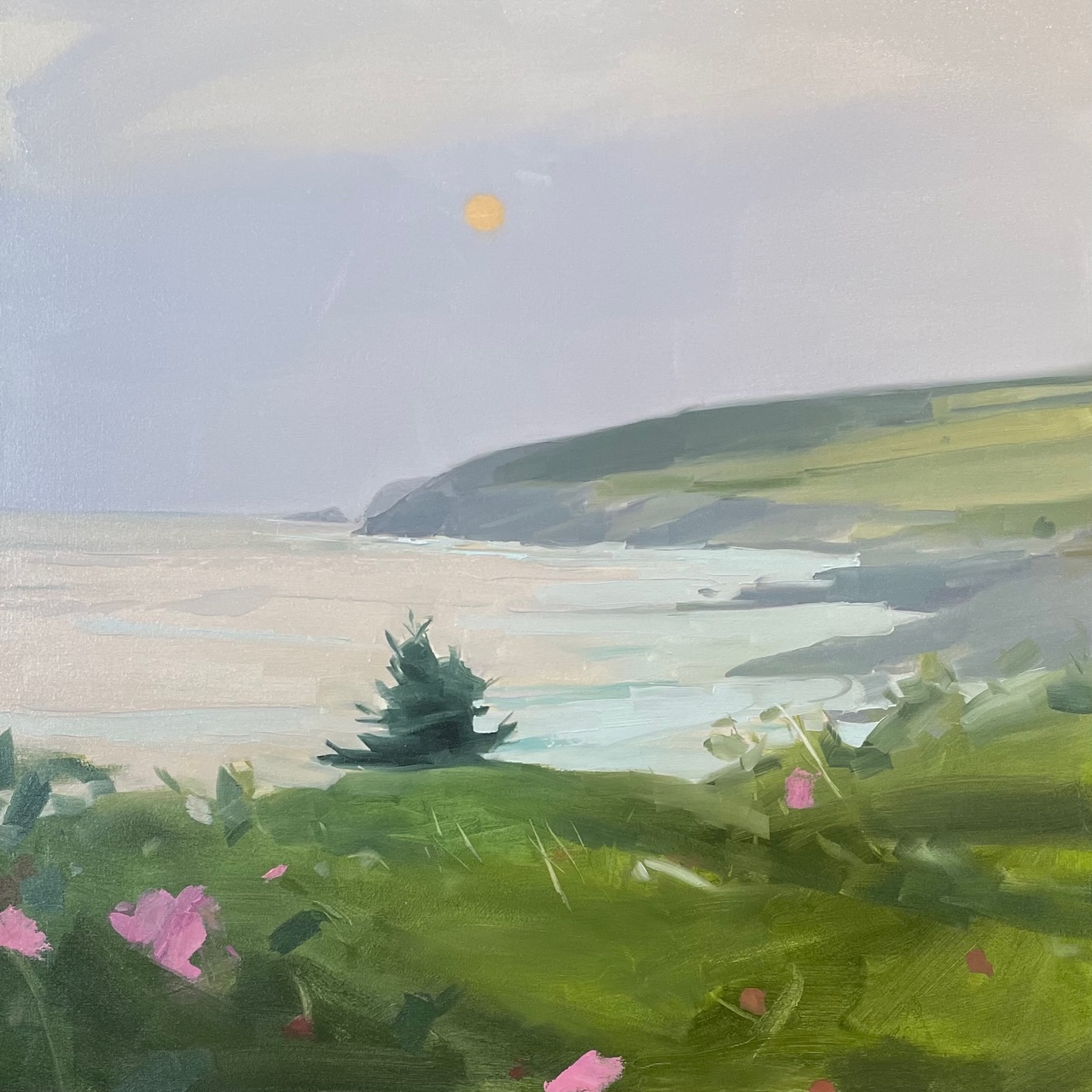

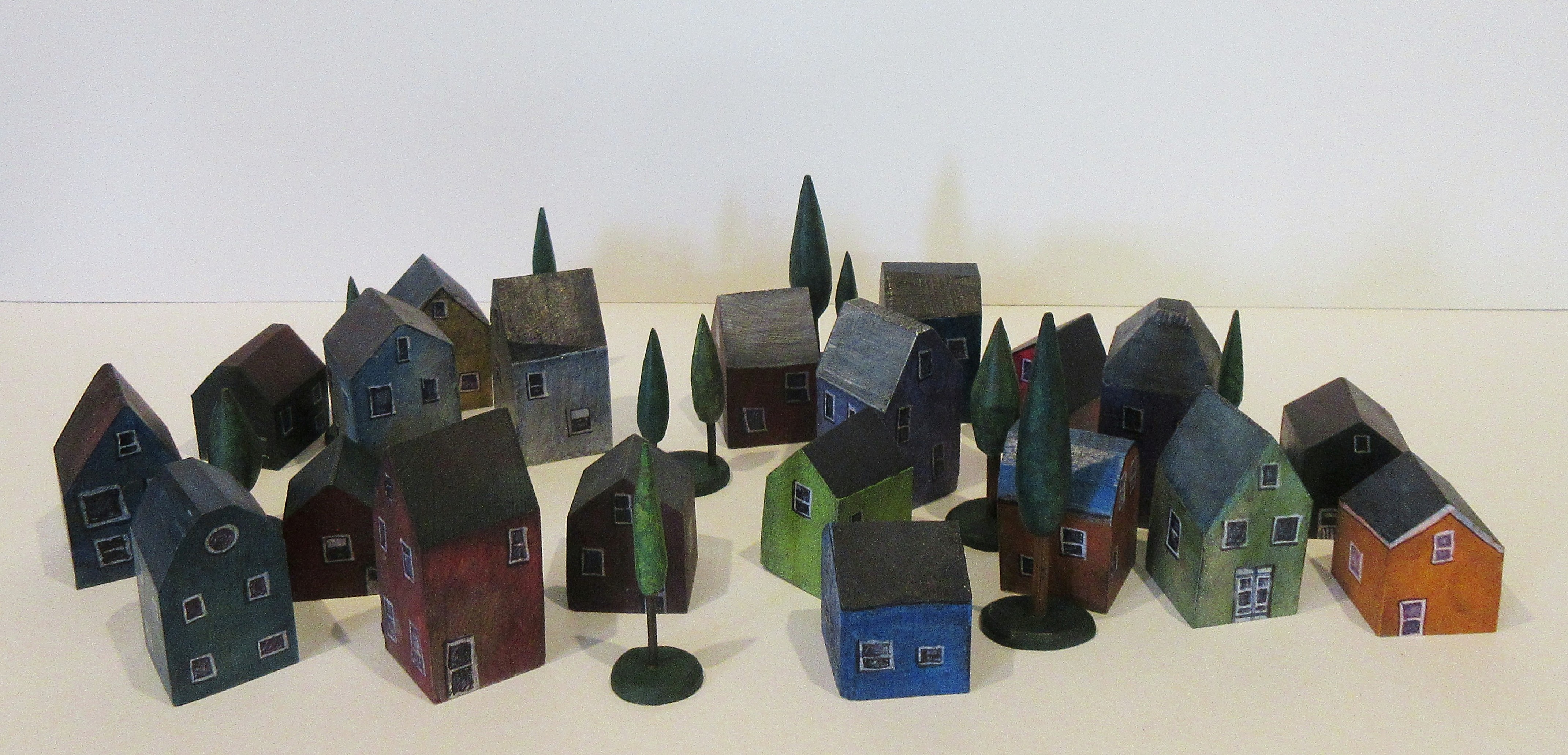
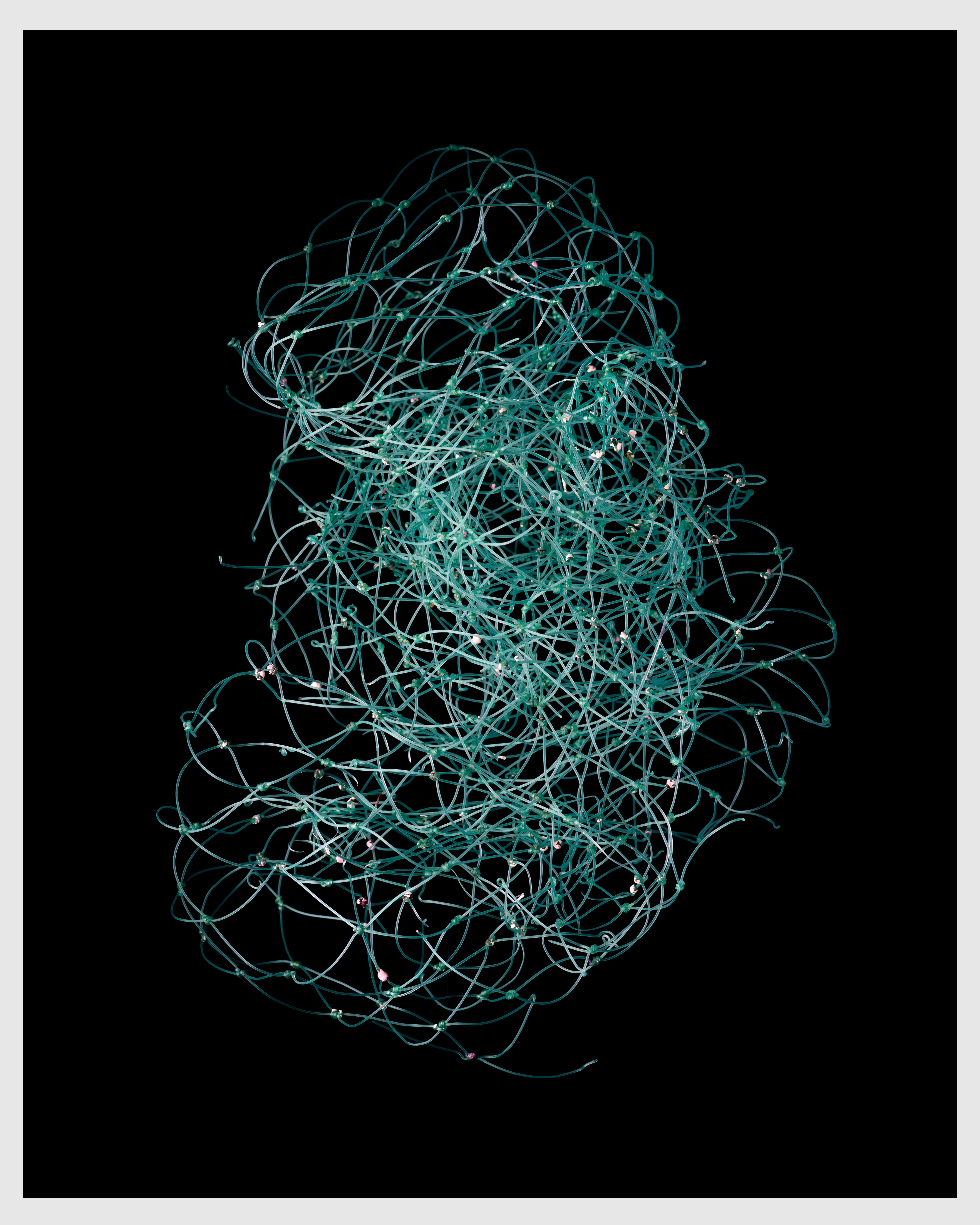
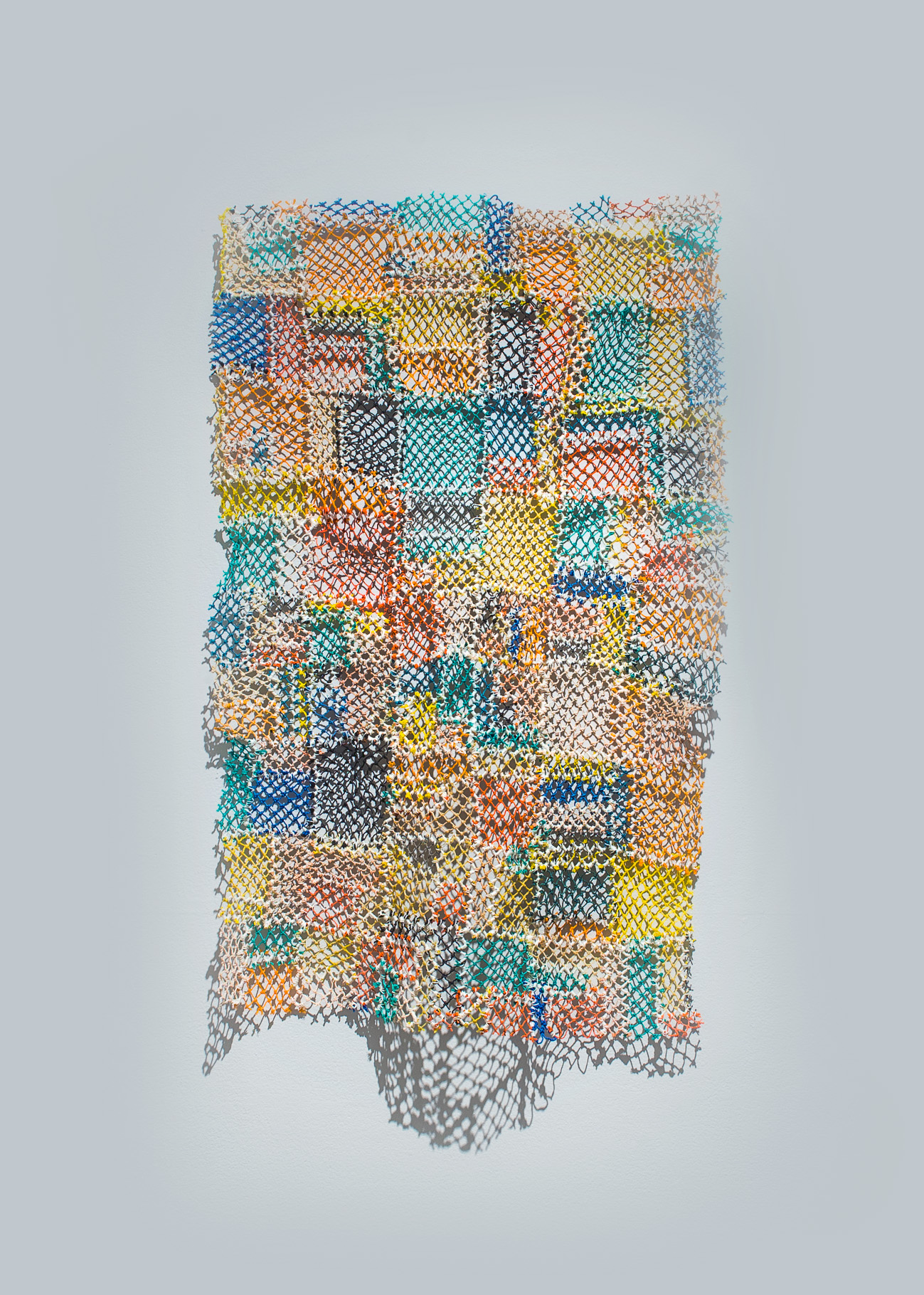
Clockwise top, left, Sunrise, September 26, oil on canvas, Sara MacCulloch; Fog Pusher, wool and silk on burlap, Laura Kenney; Semi Rural Landscape, reclaimed pine, acrylic paint, Ian Gilson, inspired by the houses in F. Scott MacLeod’s paintings; Ghost Net; Celestia, giclee print, Declan O’Dowd; Crazy Quilt, reclaimed bait bags, nylon twine, Carley Mullally. (Contributed)
the places I miss and Newfoundland
Sara MacCulloch has a sumptuous show of Nova Scotia and Pouch Cove landscapes at Katzman Art Projects, formerly Studio 21, at 5431 Doyle St. (open Tuesday through Saturday, 12 to 5).
MacCulloch now lives in Toronto and exhibits her memory paintings of the places she misses from Nova Scotia in the places I miss series and paintings she did immediately after experiencing the land during a 2023 residency with the Pouch Cove Foundation in the Newfoundland series.
In the Newfoundland works, she says in a statement, “I was able to experience the landscape, and then go directly to my studio and paint it. Rather than a longing to be there, the compulsion was to hold onto the experience of place immediately, while its impression was still fresh in my mind. These paintings are of places near the studio, within walking distance. The process of seeing it and then painting it almost always in the same day.”
The variety of painting styles and colours in this exhibit are lovely: pale orange sherbet sunsets; brooding blue storm clouds above a sliver of hot light.
MacCulloch’s overall style is fluid and she has a remarkable ability to render things quickly and simply and just so – one pink brushstroke and you can see and smell the roses on a hill top at Pouch Cove.
With Alex Colville, Tom Forrestall and Janice Leonard, MacCulloch is one of the province’s top painters of the Annapolis Valley where she had a family summer home as a child in Summerville and where she summers with her daughter in Kingsport.
She evokes the drama of the skies, the soul-stirring space of open fields and the soft pastoral colours. She captures Blomidon perfectly with the receding pattern of bands of red-purple mud interrupted by strands of water.
These paintings from both Nova Scotia and Newfoundland feature a lot of foreground flowers before receding back to a vista: a vital spurt yellow goldenrod before the sands and sea of Conrad’s Beach near Halifax or the dense profusion of Valley wildflowers in grass. Some paintings are more tactile than others with scratches in the paint and visible ridges; others are fainter and the paint more blended; in one there are stretches of bare canvas.
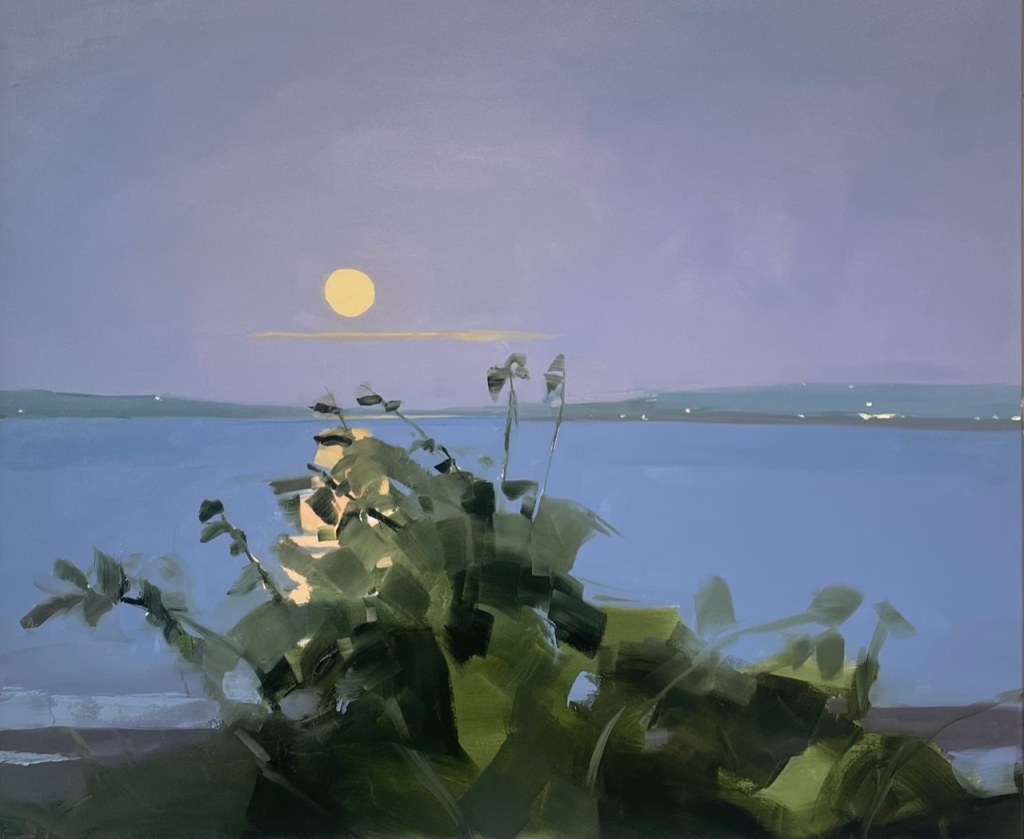
As a child, MacCulloch says, “I often found myself alone exploring the woods and fields, and along the muddy Minas basin shoreline with its shifting tides and changing light. The landscape became a kind of companion to me, and set up a pattern for my adult life – finding solace in the company of nature.”
She finds photographs and sketches don’t correctly record how she feels when she is in nature. “Thus began my ongoing occupation of trying to capture a place through painting it. Not just how it looks, but how it feels to be there.”
MacCulloch’s work is very popular and much sold online before the show opened. MacCulloch has been with Studio 21 since the gallery opened and she was a NSCAD University student.
Deborah Carver, who bought Studio 21 from founder Ineke Graham, recently sold it to Marianne Katzman, who ran her own gallery in Toronto before moving to Halifax. Katzman is keeping a lot of the current stable of artists and bringing in some new ones like Sobey Art Award nominee Eleanor King. The small ceramic gallery is closed.
THE WATER’S EDGE
In The Water’s Edge, at the Craig Gallery, Alderney Landing, to Nov. 26, photographer Declan O’Dowd and textile artist and weaver Carley Mullally find beauty and environmental crisis in the nets and lobster bands they discover as they walk along the shoreline.
Their finely constructed artworks carry within them the knowledge that marine waste is a killer. No one can look at O’Dowd’s iconic sisal rope shaped like an elegant pear and photographed as if it were an exotic, otherworldly being and not be uncomfortable thinking of the damage done by discarded fishing gear.
Similarly Mullally’s cozy hangings, of a tri-coloured rug and a towel with blue hearts, are woven out of thousands of reclaimed lobster bands. She creates contemporary artworks that mimic homespun, rural domestic objects; one thinks of comfy country homes and dying sea creatures in polluted waters.
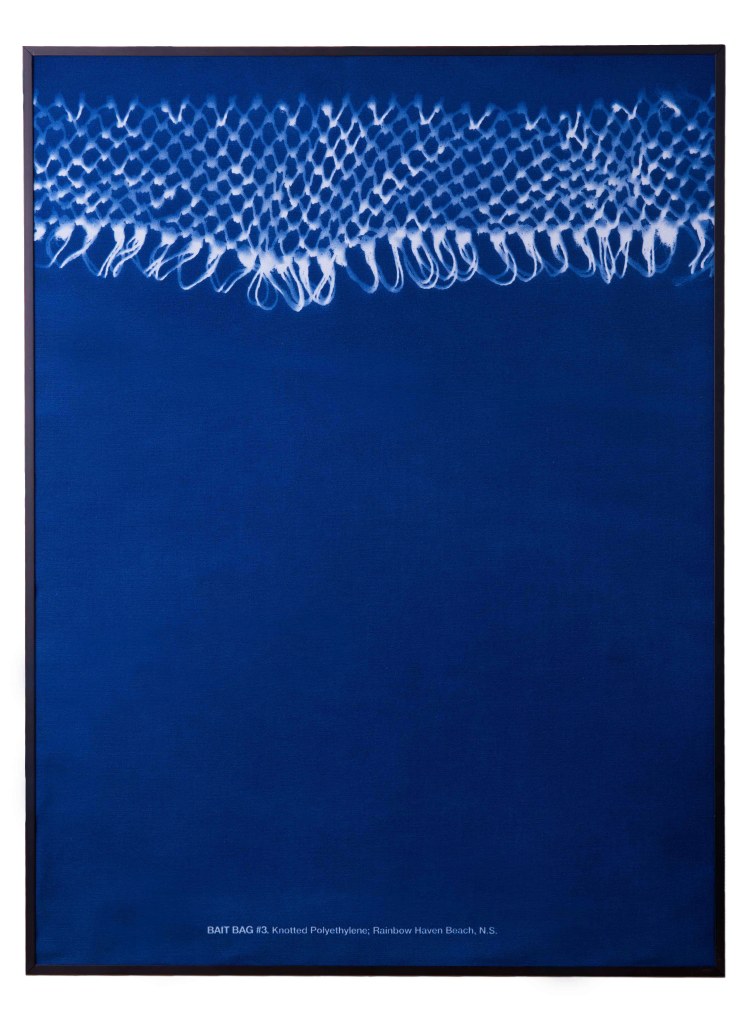
Both artists, who are NSCAD University graduates, transform found and discarded material into fine art and both, who did not know each other before the show, walk the beaches and meditate on what they find.
“The friction between the vast, immense natural beauty of the ocean with the found manmade materials brings to light environmental concerns, concepts of sustenance, mental health and gender,” they say in shared artist statement.
Mullally comes from a fishing family and her work in particular has a subcurrent about gender in that the fishing industry is traditionally a male one and the domestic arts of weaving and quiltmaking are traditionally female.
Irrational Repair; May 2021-Present, of reclaimed bait bags and twine, is a lineup of delicate-looking pieces of netting mended in all sorts of textile techniques. They look abstract and magically like lace.
The saturated and dreamy blue of O’Dowd’s contact print cyanotypes suggests a deep ocean in which a ghostly piece of net floats in its own universe; these works are lovely, haunting and disturbing. The concept for this Bait Bag series “both emulates and subverts” how British botanist, photographer and cyanotype pioneer Anna Atkins documented her collected dried-algae in 1842, says O’Dowd.
He copied Atkins’ image orientation and naming method labelling the nets as specimens in order to re-enforce “the connection between the object and the material it was manufactured with, in this case the most widely used petroleum based plastic in the word; Polyethylene.”
His studio-based photographs in the Ghost Net series are beautifully lit against dark backgrounds and have a celestial feel as the central netting is formed into delicate, sometimes figurative, other times galactic objects.
These are high-resolution portraits of specimens of washed-up fishing debris from the Nova Scotia shore. In keeping with scientific cataloguing, O’Dowd hangs them from a thin fishing line and rotates them in space like mobiles.
WOOD AND WOOL: Ian Gilson and Laura Kenney
Hooked rug artist Laura Kenney and toy maker/assemblage artist Ian Gilmore are both playful and political in their work.
Their shared exhibit at Secord Gallery is a wonder of detail and material magic and is strong on thematic connections. Both comment on the housing crisis, environmental challenges and the threat to lighthouses while Kenney spins off into a more feminist direction and Gilmore into moods and an exploration of where the world of the child meets that of the adult.
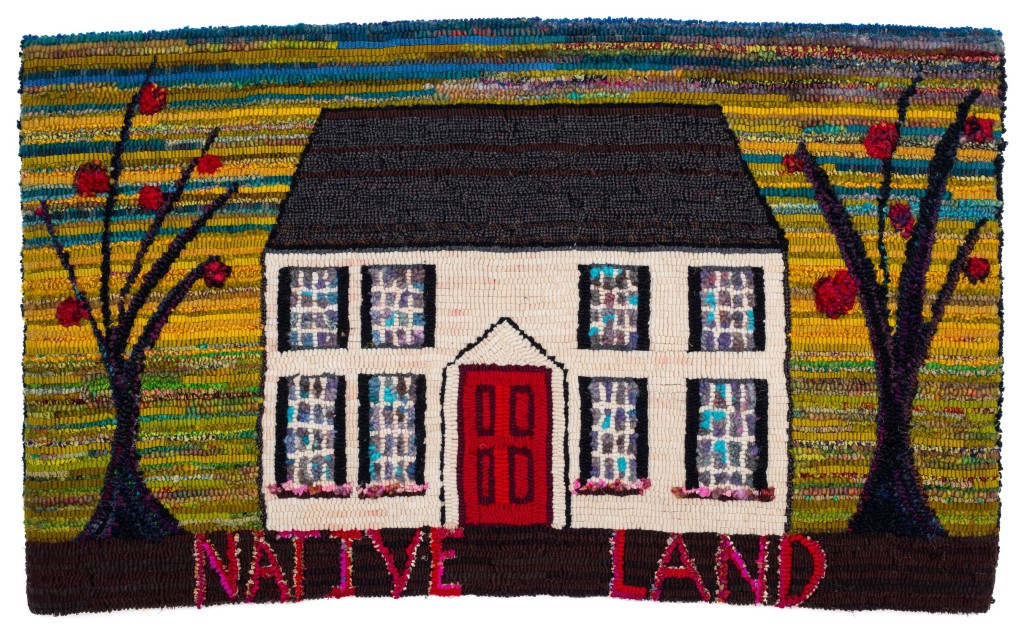
There is a delicious irony in Kenney’s use of a traditional, tactile, homespun domestic art in rugs that are warming to the foot and the heart to comment on social and political issues.
Her character Judy, party drawn from rural Maritime life and folk art, is a tall, thin woman with red hair pulled back in a bun. She is faceless, wears a long black dress and is a feminist keen on social justice and setting things right. Judy has been a saviour of lighthouses and a critic of the commercialization of Maud Lewis for the profit of others.
Maud Lewis’s three cats, framed on Judy’s wall, look on gleefully as Judy irons a white, suited man on her ironing board in Straighten Him Out.
Kenney’s sense of humour and her brilliant use of colour with gorgeous banded backgrounds make her imagery delightful and seemingly carefree. As gorgeous as the flames and purple and blue banded sky are in Putting Out The Fires, the depiction of Judy using a watering can to put out this past summer’s wildfires is disturbing.
The cheerful colours in window panes and pink flowers on window sills in Our Home on Native Land belie the socio-political comment Kenney is making about colonization and the loss of Indigenous land and culture. The door of the quintessential white, country house is red.
Gilson has a darker more fantastical edge than Kenney. His is the world of making what’s needed from what’s at hand, from digging in the tool box and roaming in the wood shed or the attics of old houses. He builds an enchanting world rooted in story and informed by clowns, carnivals, architecture and toys.
Gilson’s works are delightful in their miniature aspect and in the “how” of his construction. He builds a tiny towering lighthouse out of a jumble of miniature, handmade tables and chairs with a lit desk lamp as the lighthouse’s light. The artwork Poltergeist is an elegant vertical structure of barely connected, perfectly constructed, doll house chairs reaching up to heaven.
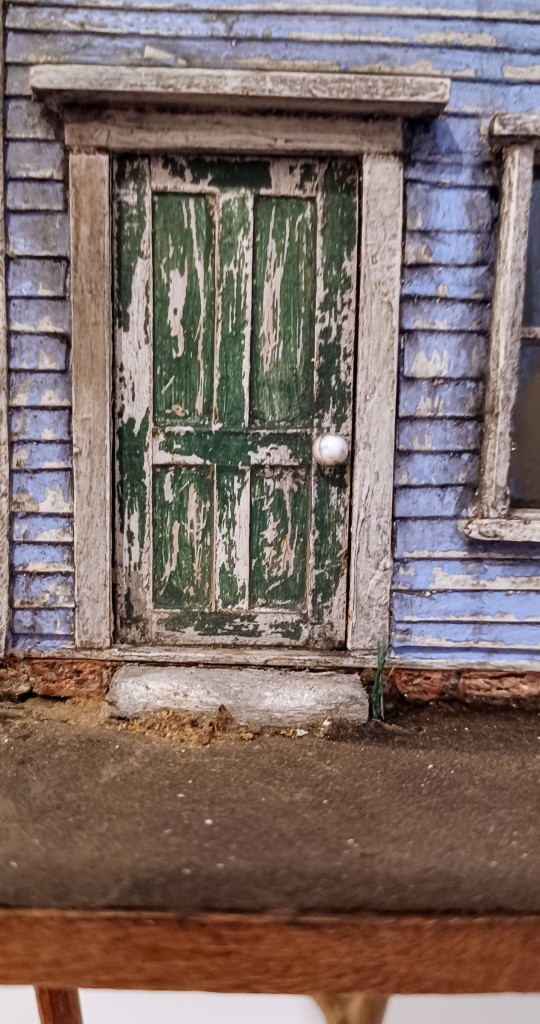
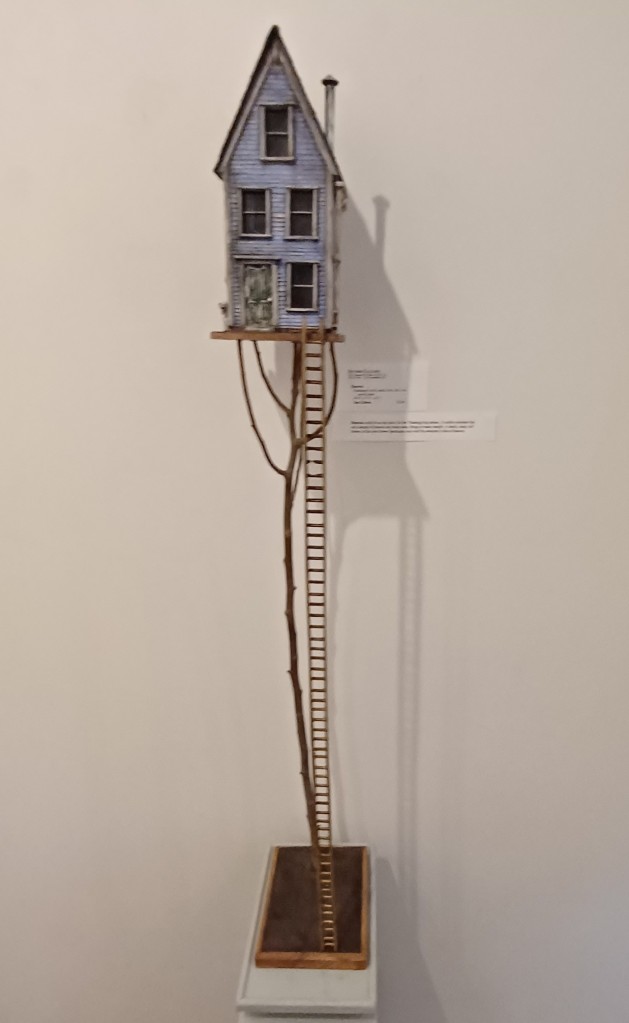
Note the exquisite detail in the miniature door in Ian Gilson’s idea of heaven in Heaven, of reclaimed wood, metal, wire, zinc, paper, acrylic paint, wax.
Gilson’s toys are comical and not for the faint of heart. The Funt Toys series of sculpted then cast and hand-painted and hand-packaged objects includes Billy Bacon – a strip of bacon with eyes and a cigarette in its mouth. I won’t describe Meat Landscape.
The Rabbits in the Secret Toys for Lonely Children series are wonderful in a creepy way. These mutant, long-eared stuffies have perfectly crafted, cranky, adult faces, sculpted hands and little furry bodies. They look like fairytale creatures or the Japanese Monchhichi monkeys.
ELEMENTAL
Close to Katzman Art Projects, on the fifth floor of the Halifax Central Library, quilt artist Marilyn Smulders and painter Danny Abriel serve up a blast of colour and carefully constructed, graphic imagery.
Smulders works in largely traditional patterns with some slight abstractions and pictorial elements. She honours the beauty inherent in traditional patterns and expresses her feelings about Nova Scotia landscape in exquisite, bold, colour choices.
Abriel also creates painted acrylic landscapes with a lot of energizing pattern in black outlines and robust colour. The two sunset images twinned together on the wall of the Sunroom Cafe are amazing.
For this exhibition, on to Dec. 3, the two friends responded to sky, earth, and water and each other’s work.
As they say in a statement: “Imagine loon calls, water lapping on a rocky beach, wind whistling through towering pines and hemlocks. Envision ombre sunsets and spectacular night skies, inky black and diamond-studded. Picture mudflats of deepest red and tide-carved shorelines.”
Smulders also exhibits with Andrea Tsang Jackson in By Her Hand: Contemporary Quilts Inspired by the Nova Scotia Museum at the Nova Scotia Museum.
The two artists created contemporary quilts in response to examples of historic quilts chosen in collaboration with Lisa Bower, assistant curator, Nova Scotia Museum. By Her Hand at the Nova Scotia Museum of Natural History to Jan. 7, 2024.
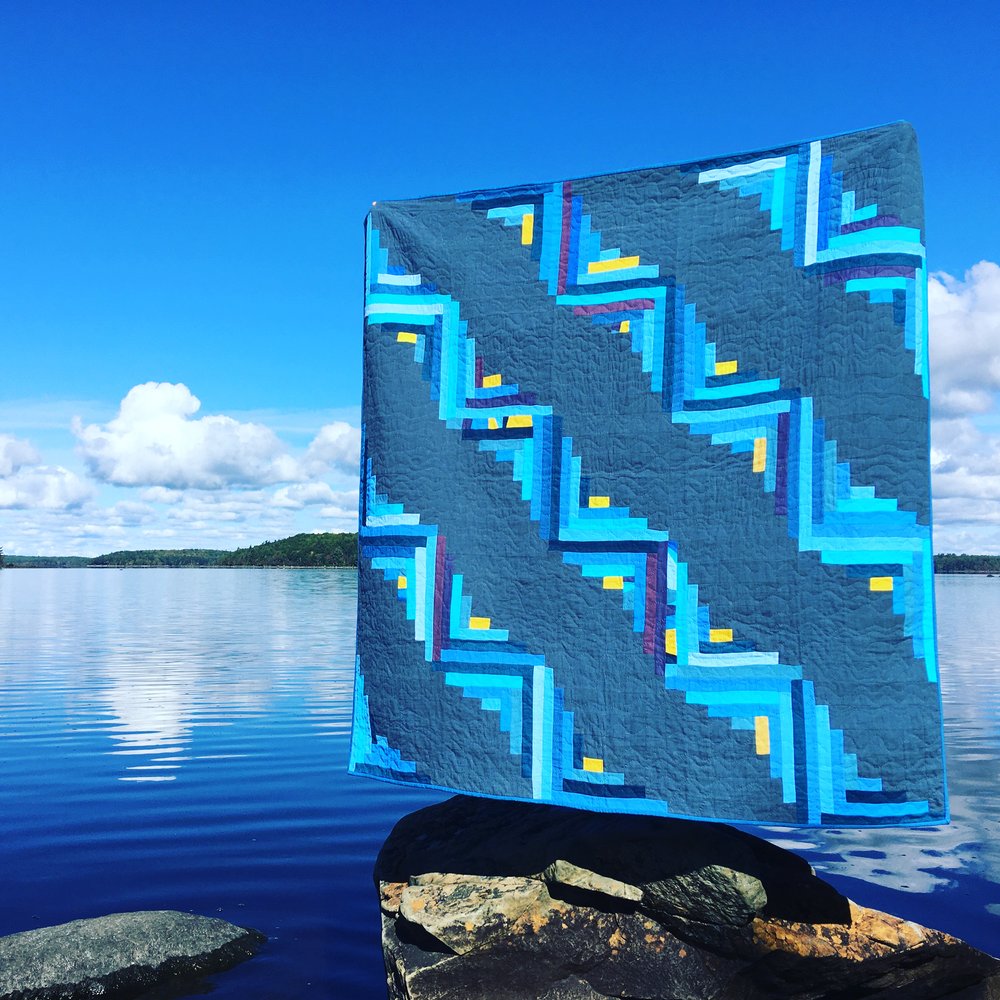
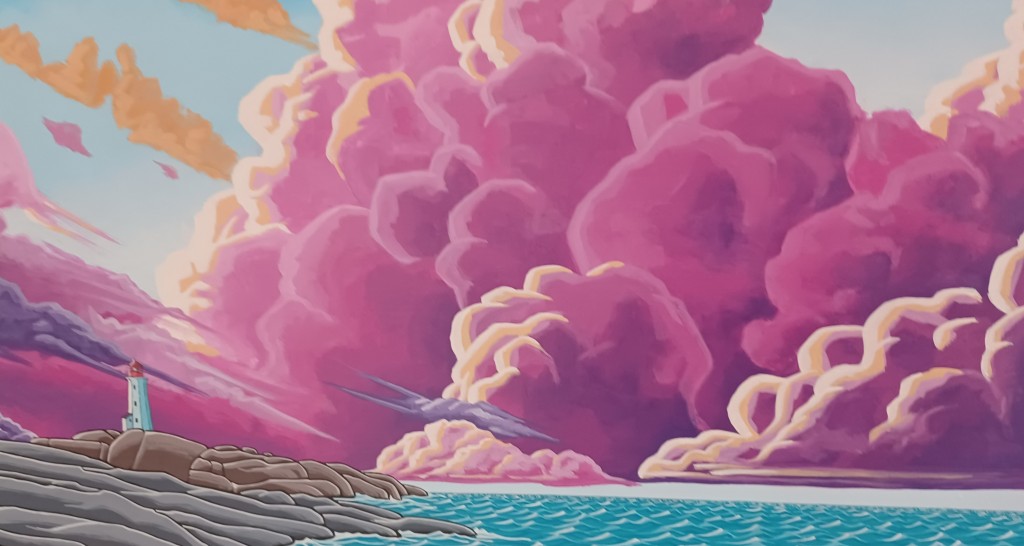
- Every Brilliant Thing: intimate, participatory play about everyday joy tours Annapolis Valley
- A Fantastic Connectivity of Colour, Movement and Soul in reView
Categories: Uncategorized
Great article Elissa!
LikeLike
thanks Jaye! Bet your sea is storm-tossed today
LikeLike
Pretty quiet today but there have been days when it has been pretty crazy. Hope everything is wonderful with you!!
LikeLike
Hello Elissa,
I have only just discovered your excellent blog! Congratulations on continuing your long commitment to culture in Nova Scotia.
All the best from Guelph, ON.
Take care,
Ron Shuebrook
LikeLike
Just seeing this now! Thanks! I am afraid it’s sporadic. Hope you are doing great. Elissa
LikeLike
Good to hear from you and thank you. Hope the winter is treating you well! Elissa
LikeLike